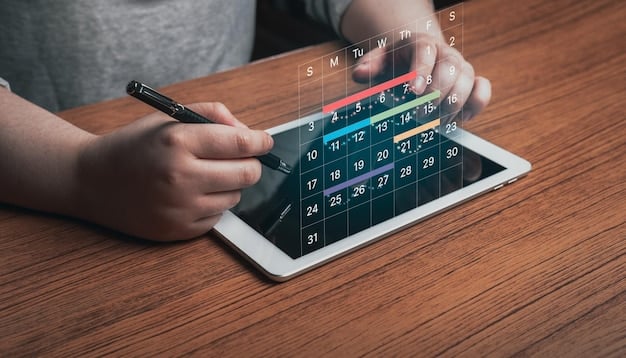Boost Your Productivity: Time Blocking with Strategies for US Pros in 2025

Boost your productivity in 2025 by mastering time blocking, a powerful task management strategy that helps US professionals allocate specific time slots for tasks, leading to increased focus and efficiency.
Are you a US professional aiming to enhance your efficiency and achieve peak performance in 2025? One of the most effective strategies to consider is mastering the art of time blocking. This technique involves planning your day in specific blocks of time dedicated to particular tasks, transforming how you manage your workload and ultimately achieve your professional goals.
Understanding Time Blocking: The Core Principles
Time blocking is a productivity method that involves dividing your day into specific blocks of time, each dedicated to a particular task or group of tasks. Rather than simply working through a to-do list, time blocking encourages you to schedule when and how you will accomplish each task.
Why Time Blocking Works
The effectiveness of time blocking lies in its ability to create structure and focus. By allocating specific time slots for tasks, you reduce the likelihood of multitasking and the distraction of constantly switching between activities.
- Limits Distractions: Scheduled blocks reduce the temptation to switch tasks.
- Enhances Focus: Concentrated effort on one task at a time.
- Promotes Realistic Planning: Forces you to estimate how long tasks will actually take.
Time blocking allows you to be more mindful and intentional with your time. It also provides a visual representation of your day, week, or month, giving you a clear overview of your commitments and helping you prioritize.

Implementing Time Blocking: A Step-by-Step Guide for US Professionals
Implementing time blocking can seem daunting at first, but breaking it down into manageable steps makes it easier to incorporate into your routine. Here’s a guide to help US professionals begin using this method effectively.
Step 1: Identify Your Priorities
Before you start blocking out time, it’s essential to identify your priorities. Consider both your short-term and long-term goals and determine which tasks are most crucial for achieving them.
Step 2: Estimate Task Durations
Next, estimate how long each task will take. Be realistic, and consider potential interruptions or challenges that could extend the time needed.
Step 3: Create Your Schedule
Use a planner—either digital or physical—to create your schedule. Start by blocking out time for your most important tasks, then fill in the remaining blocks with less critical activities.
- Color-Code Your Blocks: Visually distinguish different types of tasks.
- Schedule Breaks: Include short breaks to avoid burnout.
- Be Flexible: Allow room for unexpected tasks or delays.
Effective time blocking requires adaptability. Over time, you’ll fine-tune your scheduling based on your experiences. The goal is to create a rhythm that optimizes your productivity without causing undue stress.
Tools and Techniques for Effective Time Blocking
To maximize the benefits of time blocking, it’s helpful to use the right tools and techniques. These resources can streamline the scheduling process and enhance your focus throughout the day.
Digital Calendars
Digital calendars like Google Calendar, Outlook Calendar, and Apple Calendar are excellent tools for time blocking. They allow you to easily create, modify, and view your schedule.
Physical Planners
For those who prefer a tactile approach, physical planners can be just as effective. Options like the Moleskine Weekly Planner or the Passion Planner provide structured layouts to help you organize your time.
Time Tracking Apps
Apps like Toggl Track and RescueTime can help you monitor how you spend your time, providing valuable insights for refining your schedule. By tracking your activities, you can identify time-wasting habits and adjust your blocks accordingly.
Combining these tools with techniques such as the Pomodoro Technique (working in focused 25-minute intervals) can further enhance your time blocking efforts, ensuring you stay on track and maintain a high level of productivity.

Overcoming Common Time Blocking Challenges
While time blocking can be highly effective, it’s not without its challenges. Many US professionals face obstacles such as unexpected interruptions, difficulty estimating task durations, and the temptation to procrastinate.
Dealing with Interruptions
Interruptions are a common productivity killer. To minimize their impact, try setting boundaries with colleagues, turning off notifications, and creating a quiet workspace.
Improving Task Estimation
Accurately estimating task durations takes practice. Start tracking how long tasks actually take, and adjust your future estimates accordingly.
Combating Procrastination
Procrastination can derail even the best-laid plans. Break large tasks into smaller, more manageable steps, and reward yourself for completing them.
- Set Realistic Goals: Avoid overwhelming yourself with too much work.
- Use Time Management Techniques: Like the Pomodoro Technique.
- Find an Accountability Partner: To stay on track and motivated.
By addressing these challenges head-on, you can improve your time blocking skills and achieve greater productivity.
Tailoring Time Blocking to Fit Your Professional Role
Time blocking is not a one-size-fits-all solution. To maximize its effectiveness, you need to tailor it to your specific professional role and the demands of your job. The strategies that work for a freelance writer might not be ideal for a project manager or a sales executive.
For Project Managers
Project managers can use time blocking to schedule meetings, allocate resources, and track project progress. Designate time blocks for specific projects, ensuring that each gets the attention it needs.
For Sales Executives
Sales executives can allocate time blocks for prospecting, client meetings, and administrative tasks. Prioritize high-value activities like closing deals, and schedule time for follow-up communication.
For Freelance Writers
Freelance writers can use time blocking to set aside dedicated writing time, manage client communications, and handle administrative tasks. Break up writing blocks with short breaks to maintain focus and creativity.
By customizing your time blocking approach, you can create a system that aligns with your unique responsibilities and maximizes your productivity.
The Future of Time Blocking: Trends in 2025
As technology continues to evolve, so too will the strategies and tools we use for time blocking. In 2025, we can expect to see several key trends shaping the future of this productivity method.
AI-Powered Scheduling
Artificial intelligence will play a larger role in helping us manage our time. AI-powered scheduling tools will analyze our habits, preferences, and priorities to create optimized schedules automatically.
Integration with Smart Devices
Time blocking will become more integrated with smart devices. Imagine your smart speaker reminding you when it’s time to switch tasks or your smartwatch alerting you to upcoming meetings.
Focus on Mental Wellbeing
The emphasis on mental wellbeing will continue to grow. Time blocking will not only focus on productivity but also on scheduling time for mindfulness, exercise, and relaxation.
These trends underscore the importance of staying adaptable and open to new approaches. By embracing these advancements, US professionals can unlock even greater levels of productivity and personal satisfaction.
| Key Point | Brief Description |
|---|---|
| ⏰ Prioritize Tasks | Identify and schedule the most important tasks first for optimal productivity. |
| 📅 Schedule Blocks | Allocate specific time blocks in your calendar for focused work. |
| ⏱️ Time Tracking | Use apps to monitor how you spend your time, refining your schedule. |
| 🧘 Mental Wellbeing | Schedule time for mindfulness, exercise, and relaxation for overall wellbeing. |
FAQ: Time Blocking for US Professionals
▼
Time blocking is a method of scheduling your day in specific blocks of time, each dedicated to a particular task, enhancing focus and productivity.
▼
Digital calendars like Google Calendar or physical planners such as the Passion Planner are both effective for time blocking.
▼
Minimize interruptions by setting boundaries, turning off notifications, and creating a quiet workspace to maintain focus.
▼
Yes, but it should be tailored to fit the specific responsibilities and demands of your job, adapting it to your unique needs.
▼
Future trends include AI-powered scheduling, integration with smart devices, and a greater focus on mental wellbeing alongside productivity.
Conclusion
As US professionals gear up for 2025, mastering time blocking can be a game-changer for boosting productivity. By understanding its core principles, implementing effective strategies, and tailoring it to fit your unique role, you can enhance focus, manage your workload efficiently, and achieve your professional goals.





